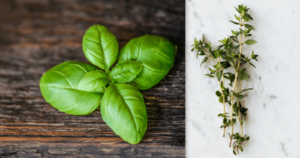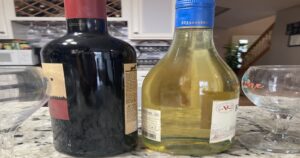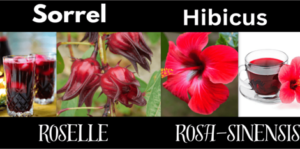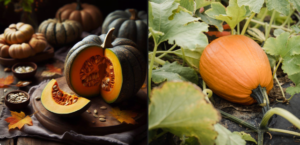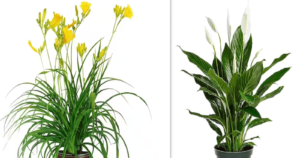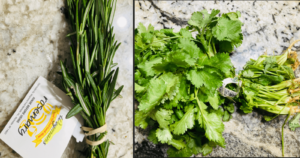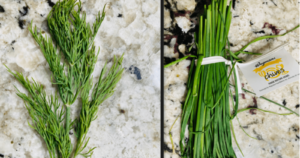Tiki Thyme (Coleus amboinicus Or Plectranthus Amboinicus) is a mint-family plant that can reach about 3 feet (1 m) tall. Its thick stems (1–3 feet long) start out hairy—either with stiff long hairs or soft short ones—and become smooth as they age.
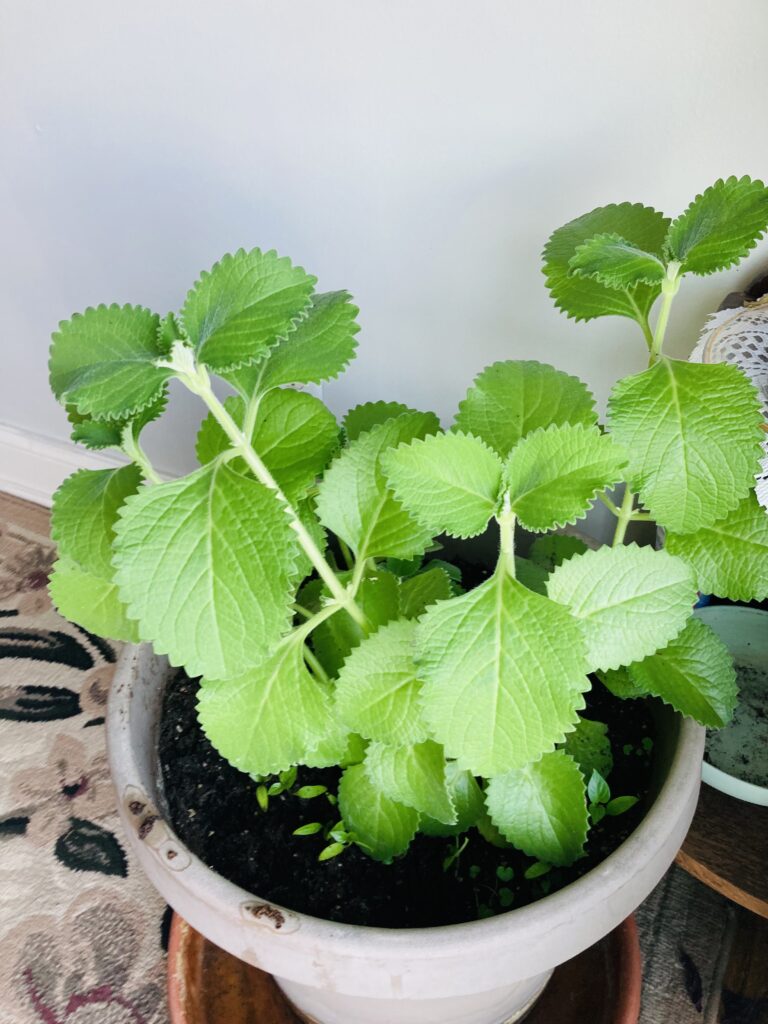
The leaves are fleshy succulent , oval-shaped (2–3 inches long, 1.5–2.5 inches wide), with scalloped edges and a pointed tip. Tiny hairs cover the leaves—especially underneath—making them look slightly frosted.
What is Plectranthus amboinicus, and Why Is It Called Tiki Thyme or Cuban Oregano?
Plectranthus amboinicus, also known as Coleus amboinicus, is a hardy, aromatic herb from the mint family prized for both its flavor and medicinal value. With thick, succulent-like leaves and a bold, thyme-meets-oregano scent, it’s earned the nickname Tiki Thyme in tropical gardens and Cuban oregano in kitchens across the Caribbean and beyond.
Despite the oregano label, it’s not a true oregano but a tropical perennial believed to have originated in Africa and Asia, later spreading to warm climates worldwide. In cooking, it adds a robust, herbal punch to stews, soups, and meat dishes; in traditional medicine, it’s valued for soothing coughs, colds, and skin irritations. Its multiple names reflect its global journey—each culture adopting it for both flavor and healing.
How to Identify Coleus amboinicus Or Plectranthus Amboinicus (Tiki Thyme, Cuban Oregano, Mexican Mint, Indian borage)
- Thick, scalloped leaves: Succulent, oval leaves with coarse, crenate margins.
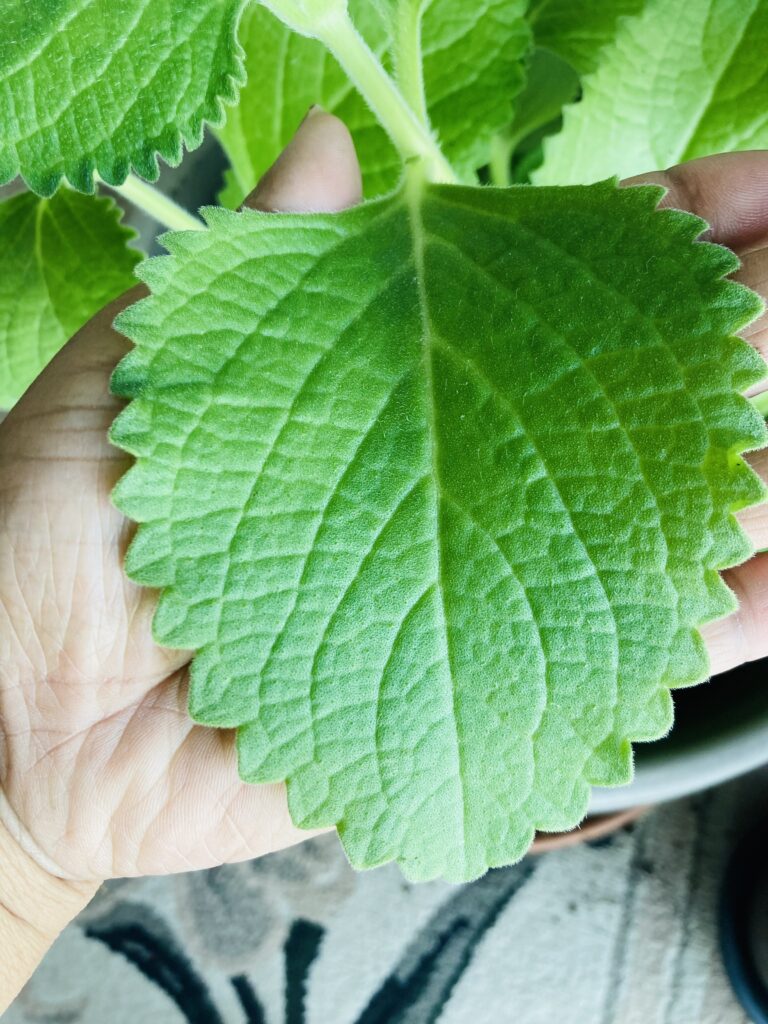
2. Strong oregano scent: Crushing a leaf releases a pungent, oregano‑like aroma.
3. Square, fleshy stems: Mint‑family hallmark—stems are succulent, square in cross‑section, initially hairy, then smooth.
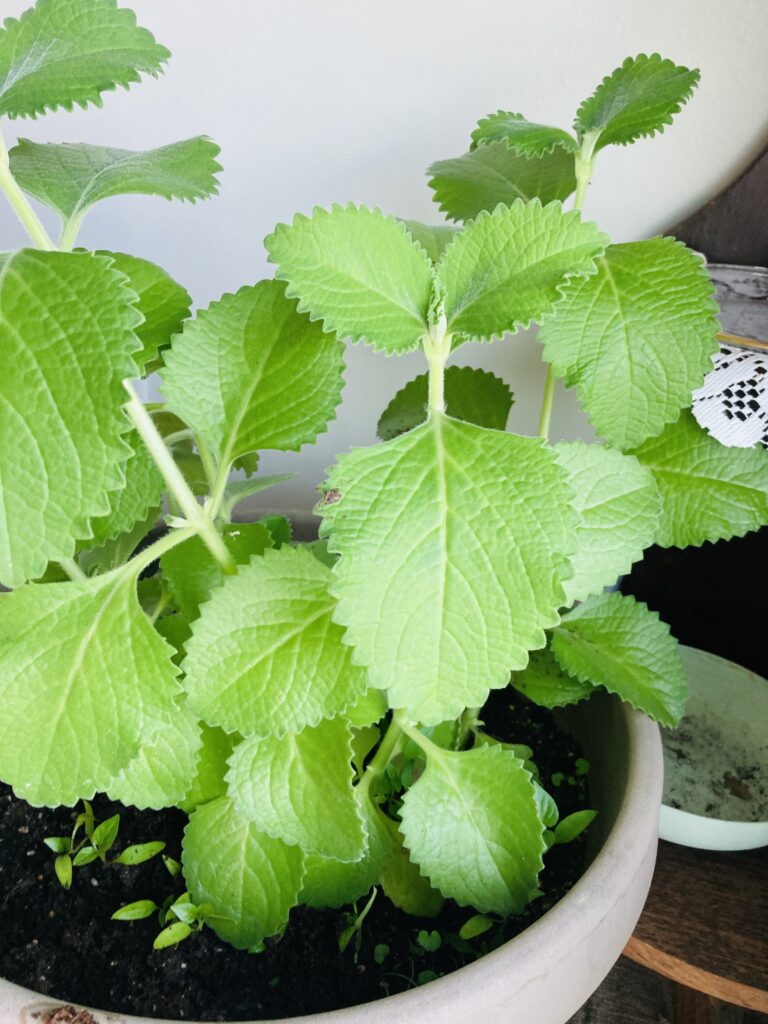
Glandular “frost” hairs: Tiny sticky hairs, especially dense on the leaf underside, give a frosted appearance.
Opposite leaf pairs: Leaves grow in matching pairs directly across the stem.
Leaves feel slightly tacky or sticky because of the glandular hairs
Common Names for Tiki thyme (Coleus Amboinicus Or Plectranthus Amboinicus) Cuban Oregano around the world
| Common Name | Region / Language |
|---|---|
| Indian borage | India (English usage) |
| Country borage | Europe & North America (horticultural trade) |
| French thyme | Europe & South Africa |
| Indian mint | India & parts of Africa |
| Mexican mint | Mexico |
| Cuban oregano | Cuba & Caribbean islands |
| Tiki Thyme | Caribbean islands |
| Soup mint | South Africa |
| Spanish thyme | Spain & Spanish‑speaking Americas |
| Broad‑leaf (or Thick‑leaf) thyme | General English usage across tropics |
| Oregano brujo (“witch oregano”) | Puerto Rico |
| Orégano francés | Spanish‑speaking countries |
| Pashan Bhedi | India (Hindi) |
| Karpooravalli | India (Tamil Nadu) |
| Panikoorka | India (Kerala) |
| Muriyan pacha / Murikooti | India (Malayalam) |
| Afrika‑tiemie / krui‑spoorsalie | South Africa (Afrikaans) |
| Chir trâchiek chrouk | Cambodia (Khmer: “pig’s‑ear mint”) |
| Chir trâchiek dâmrei | Cambodia (Khmer: “elephant’s‑ear mint”) |
| Chir sloek krah | Cambodia (Khmer: “thick‑leaf mint”) |
| Chir tròmeang | Cambodia (Khmer: “broad‑leaf mint”) |
| Hu soeua | Thailand (Thai: “tiger’s‑ear mint”) |
What Does Cuban Oregano (Tiki Thyme) Smell Like? Aromatic Profile of Coleus amboinicus”
Oregano‑like: A strong, savory kick very similar to common oregano.
Minty freshness: Underlying cool, mint‑family crispness.
Subtle citrus: Faint lemon or lime hints, especially when leaves are crushed.
Herbaceous warmth: Slightly peppery, almost spicy back‑note.
Green vegetal: A fresh “green leaf” character, not overly sweet.
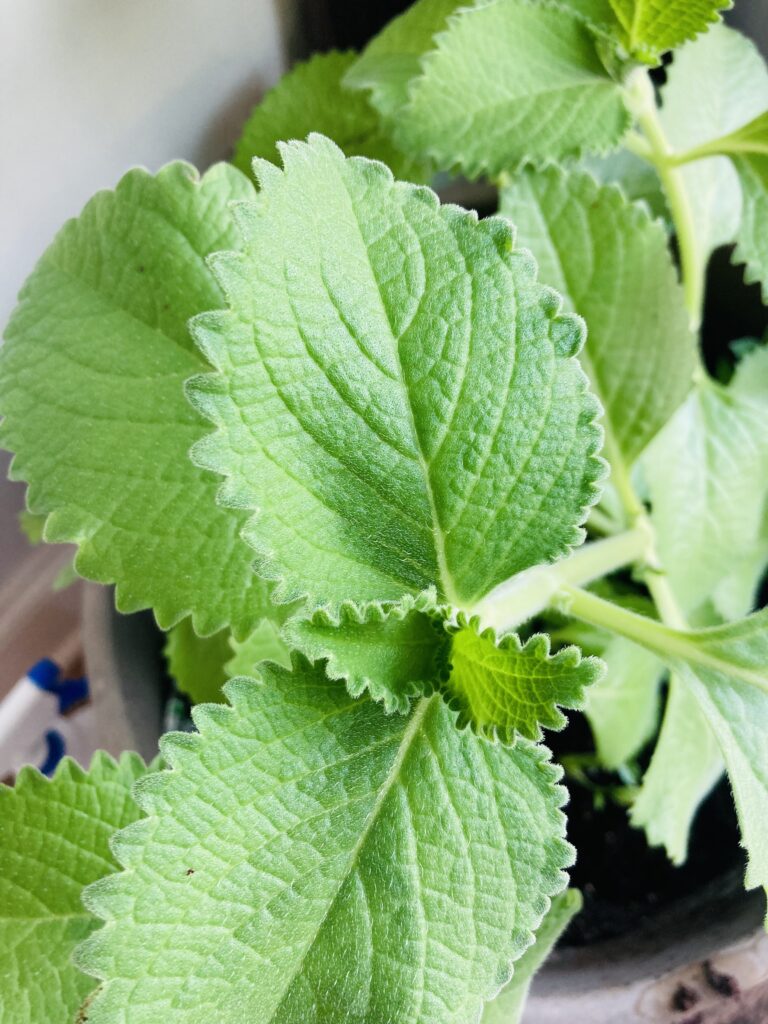
7. Common Problems affecting Tiki Thyme & Remedy
| Symptom | Possible Cause | Remedy |
|---|---|---|
| Yellowing lower leaves | Over-watering | Reduce frequency; check drainage. |
| Brown leaf edges/crisp leaves | Under-watering or low humidity | Increase watering/humidity. |
| Leggy growth | Insufficient light | Move closer to light or add grow light. |
| Aphids, mealybugs, spider mites | Pests | Wipe leaves with soapy water; treat with neem oil or insecticidal soap. |
Tiki Thyme’s secret to why it has Two Scientific Names, Coleus amboinicus, Plectranthus amboinicus?
Coleus amboinicus and Plectranthus amboinicus are two names for the same species of Tiki thyme. Here’s why you’ll see both names
Coleus amboinicus– This is an Older classification (genus Coleus)
Throughout the 18th and 19th centuries, botanists grouped a wide range of fleshy‑leaved, mint‑family plants into the genus Coleus. Here’s why Plectranthus amboinicus appeared as Coleus amboinicus in older works:
- Morphological Similarity
- Early taxonomists relied on visible traits—square stems, opposite leaves, and fleshy foliage—to define genera.
- Many Plectranthus species shared those hallmarks with true Coleus species (now a much smaller group), so they were lumped together.
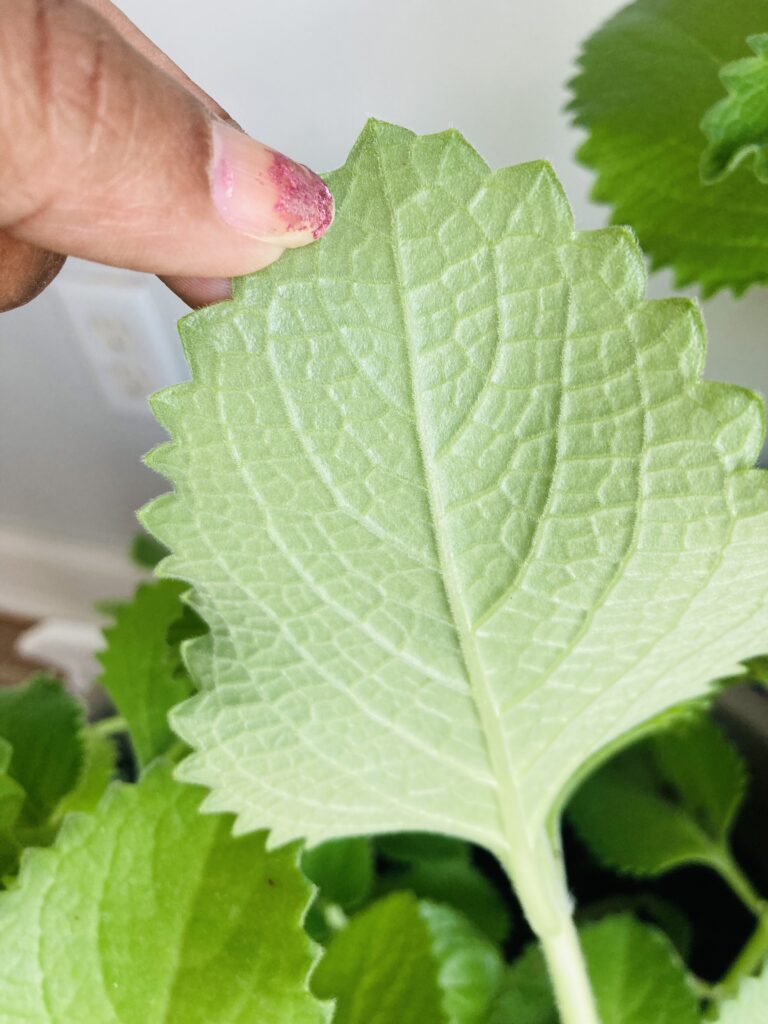
2. Limited Specimen Availability
- Botanists often worked from dried herbarium sheets or garden specimens. Without live plants or flowers, subtle differences (e.g. flower structure, gland‑hair patterns) were harder to spot, making a broad Coleus genus more practical.
3. Bentham’s 1830s Revision
- George Bentham’s influential mid‑19th‑century Flora grouped dozens of species under Coleus, including what we now call Plectranthus amboinicus.
- His arrangement set the standard for horticulture manuals and botanical gardens for over a century.
4. Horticultural Usage
- Gardeners and nurseries adopted Bentham’s names wholesale. “Coleus” became the trade name not only for ornamental leaf‑patterned cultivars but also for culinary and medicinal species like Tiki Thyme.
5. Rise of Phylogenetics (Late 20th Century)
- DNA studies revealed that the old Coleus group was polyphyletic (i.e. made up of unrelated lineages).
- In response, botanists resurrected or expanded the genus Plectranthus to house most of those species, leaving a narrower, monophyletic Coleus.
6. Modern Consensus
- Today, the correct name for Tiki Thyme is Plectranthus amboinicus.
- You’ll still see Coleus amboinicus in older books, seed catalogs, and some gardening websites, reflecting the pre‑DNA era’s broader concept of Coleus.
— Before molecular tools, botanists grouped many related mint herbs under Coleus based on shared physical traits.
— Once DNA evidence clarified their relationships, most were moved into Plectranthus, restoring Plectranthus amboinicus as the accurate name.
Is Tiki Thyme Plectranthus amboinicus Edible?
Yes—Coleus amboinicus (aka Tiki Thyme, Cuban oregano) is edible.
Culinary use: Its leaves are used as a seasoning much like oregano or thyme—toss a few finely chopped leaves into soups, stews, stir‑fries or marinades for a pungent, savory‑mint flavor.
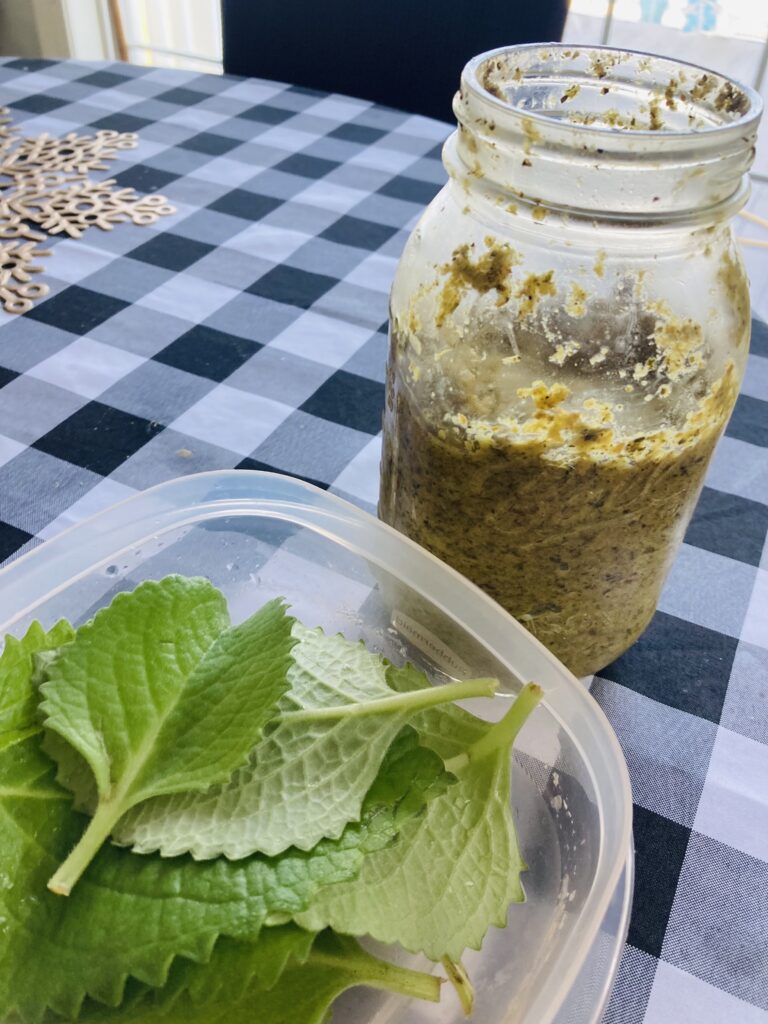
Preparation tips: Because the flavor is quite strong, start with ½–1 teaspoon of chopped leaves per serving and adjust to taste.
Raw vs. cooked: You can use the leaves fresh (torn or minced) or dried—just crush them to release their essential oils.
Safety notes: It’s generally safe for most people, but in rare cases the strong oils can irritate sensitive skin or digestion if consumed in very large amounts.
Health Benefits of Tiki Thyme or Plectranthus amboinicus.
- Antimicrobial: antibacterial, antifungal, antiviral
- Neurological & Muscle: anti-spasmodic, anti-epileptic, analgesic (pain relief), anti-acetylcholinesterase
- Anti-inflammatory & Antioxidant
- Anticancer & Antigenotoxic/Antimutagenic
- Anthelminthic (against parasitic worms)
Key Phytochemical Classes
The oils and extracts are rich in:
- Terpenoids (triterpenes, diterpenes, monoterpenes, sesquiterpenes)
- Flavonoids & Phenolics
- Quinones & Long-chain Alkylcatechols
Folk-Medicine Uses
Traditional healers use various Plectranthus species for:
- Respiratory issues (cough, bronchitis)
- Thirst and dehydration
- Muscle and skeletal aches
- Skin problems (rashes, wounds)
- Digestive disturbances (abdominal pain, GI disorders)
- As a galactagogue (to stimulate breast-milk production)
Active Ingredients of Tiki thyme
The primary bioactive constituent of Tiki Thyme ( Plectranthus amboinicus ) is the monoterpenoid phenol thymol, which can make up over 90 % of its leaf essential oil. In many chemotypes, carvacrol is also abundant and contributes significantly to its characteristic antimicrobial and anti-inflammatory effects
Thymol
- Often the dominant compound (up to ~94 % in some Indian samples)
- Known for strong antiseptic, antifungal, and anti-inflammatory activity
Carvacrol
- Can constitute 10–70 % depending on region and seasonality
- Contributes pungent “oregano‐like” aroma and broad-spectrum antimicrobial effects
Together, these two isomeric phenols are largely responsible for the traditional uses of Tiki Thyme in treating respiratory ailments, skin infections, and as a general antiseptic.
Cultural medical Use in Africa
Zulu “Iboza” Tonic for Eye and Throat Ailments
In KwaZulu‑Natal, South Africa, Plectranthus ambiguus (called “iboza”) leaves are crushed and steeped in hot water as a tonic.
It’s traditionally sipped for tonsillitis, chest complaints, fever, and even eye irritations—applications rarely mentioned outside local ethnobotanical surveys.
Snake‑bite Poultice
Among several indigenous groups in West and Central Africa, a paste made from the plant’s fleshy tubers is spread directly on snake‑bite wounds, while a decoction is taken internally as an antivenom folk remedy—a practice documented but seldom discussed in mainstream herbal compendia.
Natural Insect Repellent
Ethnobotanical records from East Africa note that crushed leaves are rubbed onto the skin to repel biting insects—especially mosquitoes—leveraging the strong essential‑oil profile of carvacrol and thymol.
Plectranthus Known Asian Uses
Conjunctivitis Eye Wash (India)
In parts of southern India, freshly crushed leaf juice is applied—as drops or a gentle wash—to soothe conjunctivitis and other inflammatory eye conditions.
Uterine Cleanser (Indonesia)
Traditional medicinal texts from Indonesia record its use as a “utero‑cleansing” herb: women drink a mild decoction postpartum to help expel lochia and tone the uterus.
Sedative Tea for Stress Relief (Sri Lanka)
In Sri Lankan folk practice, the leaves are brewed into a calming tea for those with chronic stress or insomnia—a usage that taps into its mild sedative compounds but is rarely noted in broader surveys.
Chapped‑lips and Oral Lesion Poultice (India)
Leaf juice is traditionally applied to cracked lips, mouth ulcers, and even minor burns—an application reflecting the plant’s wound‑healing and anti‑inflammatory properties.
Step-by-Step guide to successfully growing Cuban Oregano/Tiki Thyme (Coleus/Plectranthus amboinicus) indoors:
1. Choosing a Container & Soil
- Pot size: Start with a 4–6″ pot; you can up-pot to 8–10″ as the plant fills out.
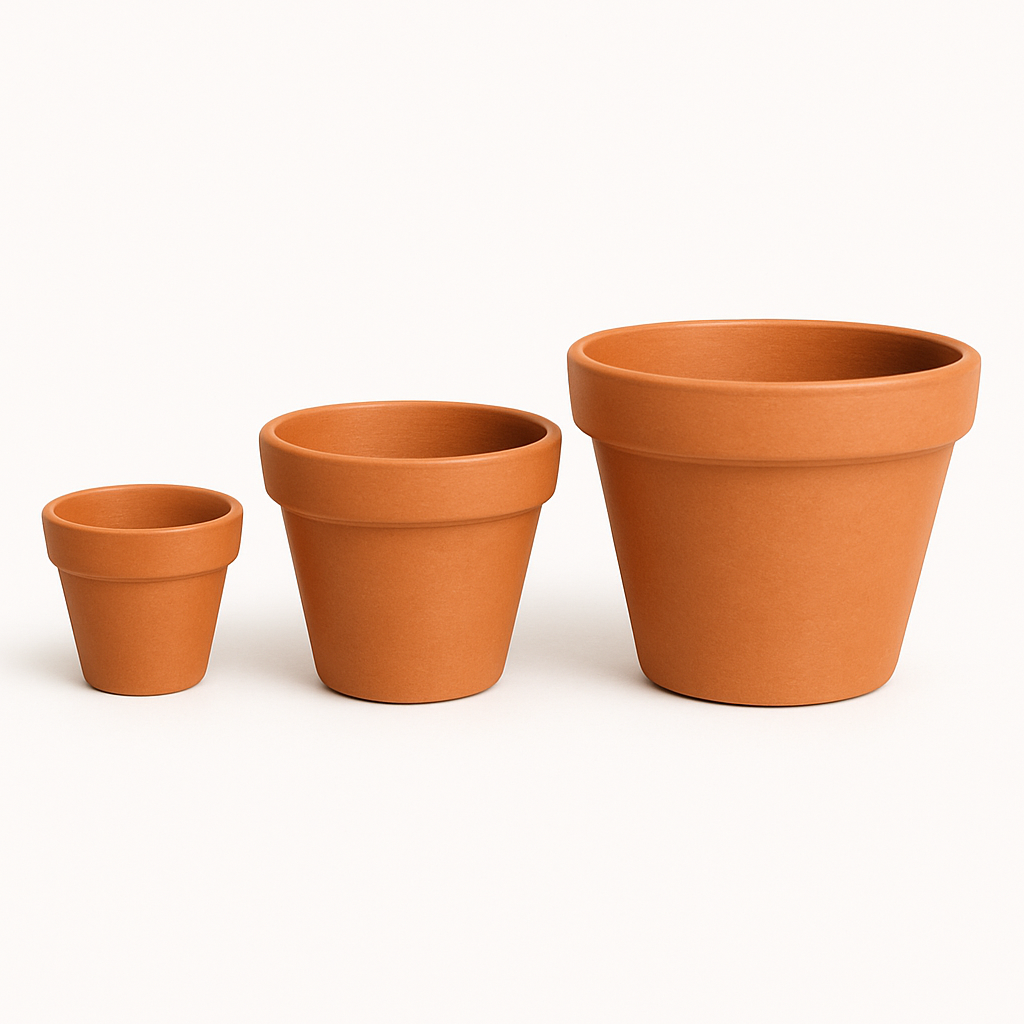
Drainage: Ensure the pot has drainage holes.
Potting mix: Use a light, well-draining mix—50% quality all-purpose potting soil + 25% perlite + 25% coarse sand or orchid bark.
2. Light Requirements
Bright, indirect light: Place near an east- or west-facing window.
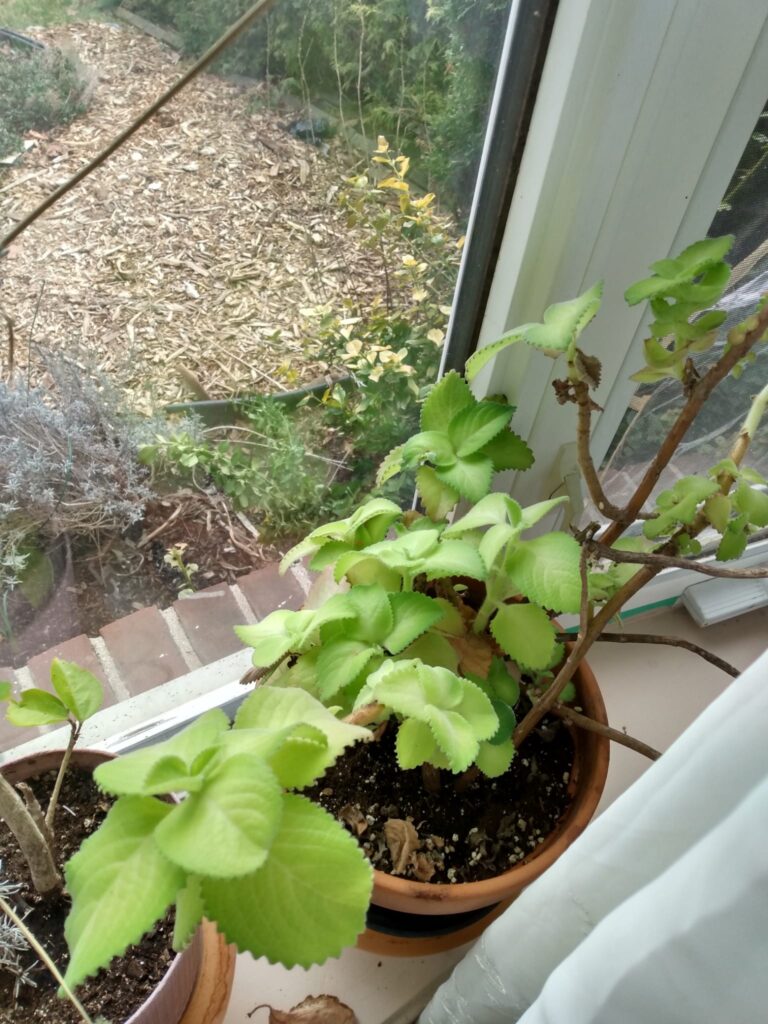
Supplemental lighting: If natural light is <6 hours/day, use a full-spectrum LED grow light ~12″ above the foliage for 10–12 hours/day.
3. Temperature & Humidity
Optimal temperature: 65–75 °F (18–24 °C).
Avoid drafts: Keep ≥10 °F above nighttime lows and away from air-coniditioner/heater vents.
Humidity: Prefers moderate (40–60%). If air is dry, set pot on a tray of moist pebbles or run a humidifier nearby.
4. Watering
- Consistency: Water when the top 1″ of soil feels dry.
- Method: Water thoroughly until it drains out; discard any excess in the saucer.
- Avoid over-watering: Do not let the plant sit in water, and avoid letting soil go bone-dry for extended periods.
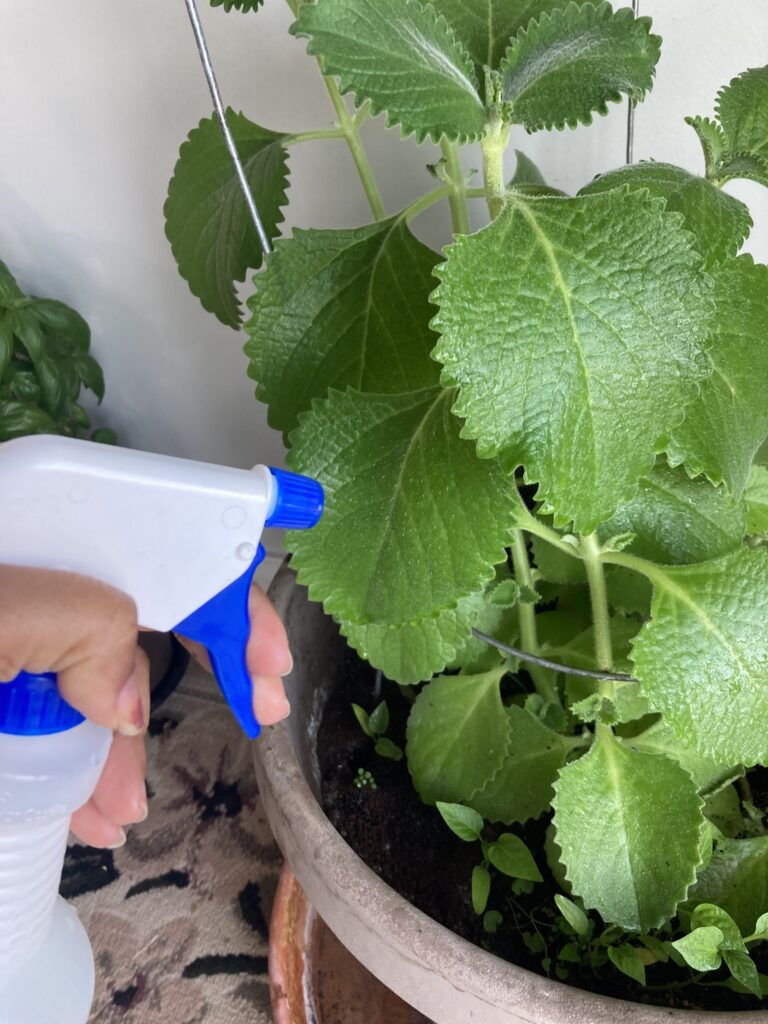
5 Fertilizing
- Frequency: Feed every 4–6 weeks during the growing season (spring through early fall).
- Type: Use a balanced, water-soluble fertilizer at ½ strength (e.g., 10-10-10 or 20-20-20).
- Flush occasionally: Once per season, run plain water through the pot to prevent salt buildup.
- Adding coffee grounds makes a great fertilizer chemical-free
6. Propagation & Pruning
- Stem cuttings:
- Snip a 3–4″ healthy tip, strip lower leaves.
- Place in water or directly into moist potting mix; roots appear in 1–2 weeks.
- Transplant to its own pot once roots are 1–2″ long.
- Pinching back: Regularly pinch or trim the growing tips to encourage bushiness and prevent legginess.
7. Misting
Use a spray bottle to occasionally mist the plant with a fine spray of water.
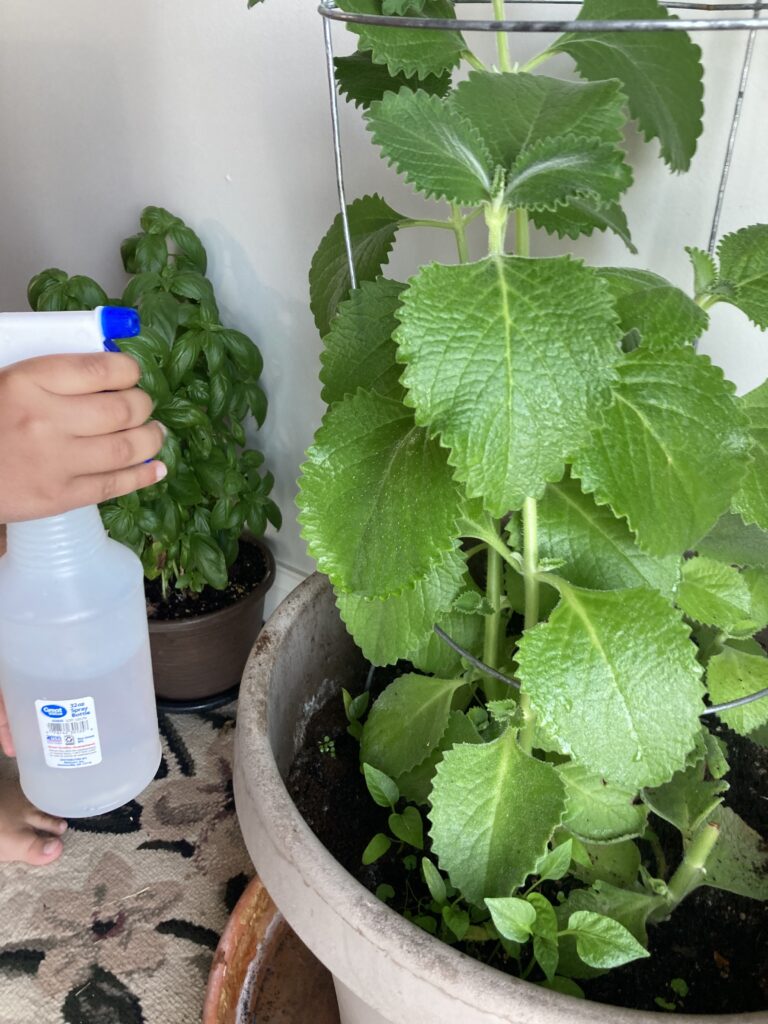
How to Successfully store Tiki thyme (Coleus amboinicus, also call Cuban oregano, Indian borage, or Mexican mint) successfully
1. Short-Term (Fresh use within 1–2 weeks)
- Method: Refrigeration
- Steps:
- Rinse gently to remove dirt.
- Pat dry completely (moisture speeds decay).
- Wrap loosely in a dry paper towel.
- Place in a perforated plastic bag or vented produce container.
- Store in your fridge’s crisper drawer.
- Tip: Avoid crushing the leaves; they bruise easily.
2. Medium-Term (1–3 months)
- Method: Freezing
- Steps:
Option A – Whole leaves:- Wash and pat dry.
- Spread leaves on a tray in a single layer, freeze for 1–2 hours.
- Transfer to an airtight freezer bag.
Option B – Chopped with oil: - Chop leaves.
- Pack into ice cube trays.
- Cover with olive oil or coconut oil (prevents freezer burn).
- Freeze, then transfer cubes to a sealed container.
- Tip: Flavor is preserved better than texture; best for cooking.
3. Long-Term (6–12 months)
- Method: Drying
- Steps:
- Rinse quickly and pat dry.
- Air dry in a warm, airy place out of direct sunlight OR use a dehydrator at 95–105°F (35–40°C).
- Once brittle, store in an airtight glass jar in a cool, dark place.
- Tip: For medicinal use, keep in amber jars to protect active compounds from light.
Extra preservation tip: If you use Tiki thyme medicinally (e.g., for cough teas or infusions), dried leaves tend to hold their potency for about 9–12 months if stored in glass, away from heat and light.
Tiki Thyme storage chart:
| Method | Shelf Life & Potency |
|---|---|
| Refrigerate fresh | 1–2 weeks • Best flavor & medicinal value |
| Freeze whole leaves | 2–3 months • Good flavor & potency |
| Freeze in oil | 3–4 months • Good flavor & potency |
| Air dry | 6–9 months • Fair flavor, good medicinal value |
| Dehydrate (low heat) | 9–12 months • Fair flavor, best medicinal value |
| Infused oil | 4–6 months • Good for cooking & topical use |
| Alcohol tincture | 2+ years • Highest medicinal preservation |
Difference between Plectranthus amboinicus/Cuban Oregano and true oregano
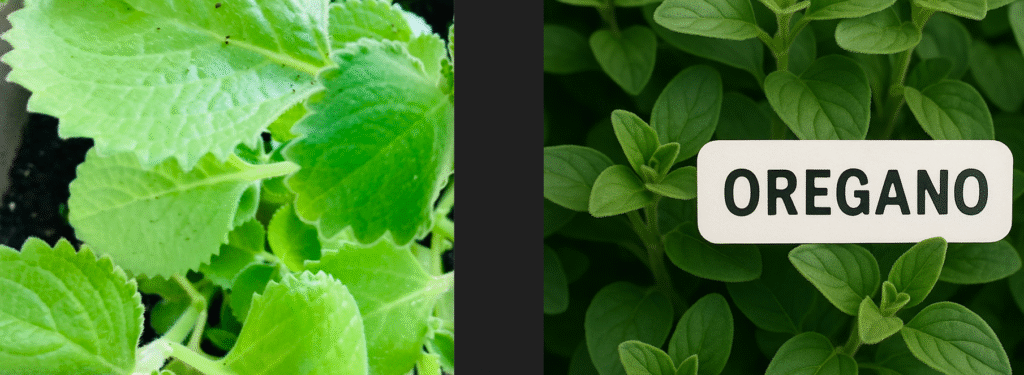
Differences Between Plectranthus amboinicus and True Oregano
- Botanical Name
- Plectranthus amboinicus (also called Coleus amboinicus)
- Origanum vulgare (true oregano)
- Plant Family
- Both belong to the mint family (Lamiaceae), but they are from different genera.
- Leaf Texture
- Plectranthus amboinicus: Thick, fleshy, and succulent-like with scalloped edges.
- Origanum vulgare: Thin, flat leaves with smooth or slightly toothed edges.
- Aroma & Flavor
- Plectranthus amboinicus: Strong, pungent, thyme-like with hints of camphor and mint.
- Origanum vulgare: Warm, earthy, peppery, and more subtle in intensity.
- Growth Habit
- Plectranthus amboinicus: Bushy, tropical perennial up to 1 m tall.
- Origanum vulgare: Low-growing, woody perennial up to 0.5 m tall.
- Climate Preference
- Plectranthus amboinicus: Thrives in warm, humid, tropical climates.
- Origanum vulgare: Prefers temperate Mediterranean climates.
- Culinary Use
- Plectranthus amboinicus: Used in Caribbean, Indian, and African dishes for strong herbal seasoning.
- Origanum vulgare: Common in Mediterranean and Italian cuisine for pasta, pizza, and sauces.
- Medicinal Uses
- Plectranthus amboinicus: Traditionally used for coughs, sore throats, and skin ailments.
- Origanum vulgare: Known for antimicrobial, antioxidant, and digestive health benefits.
- Propagation
- Plectranthus amboinicus: Easily grown from stem cuttings.
- Origanum vulgare: Grown from seeds or cuttings.
Resources
https://pmc.ncbi.nlm.nih.gov/articles/PMC10419981/#fn-group1

